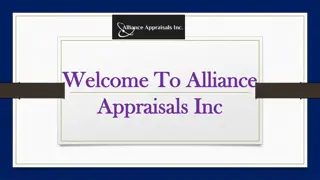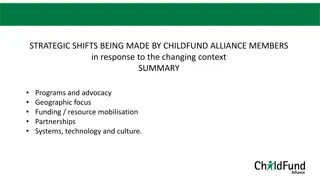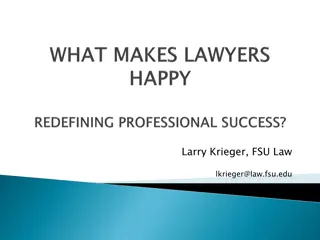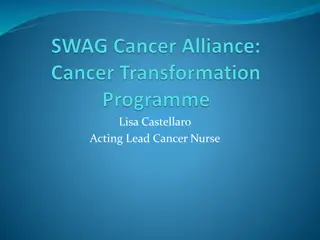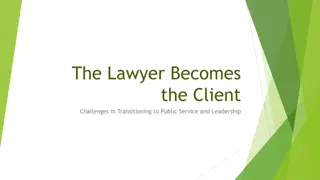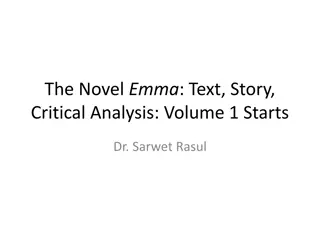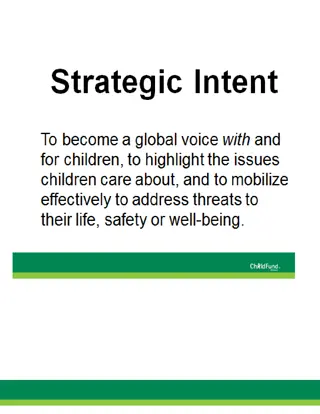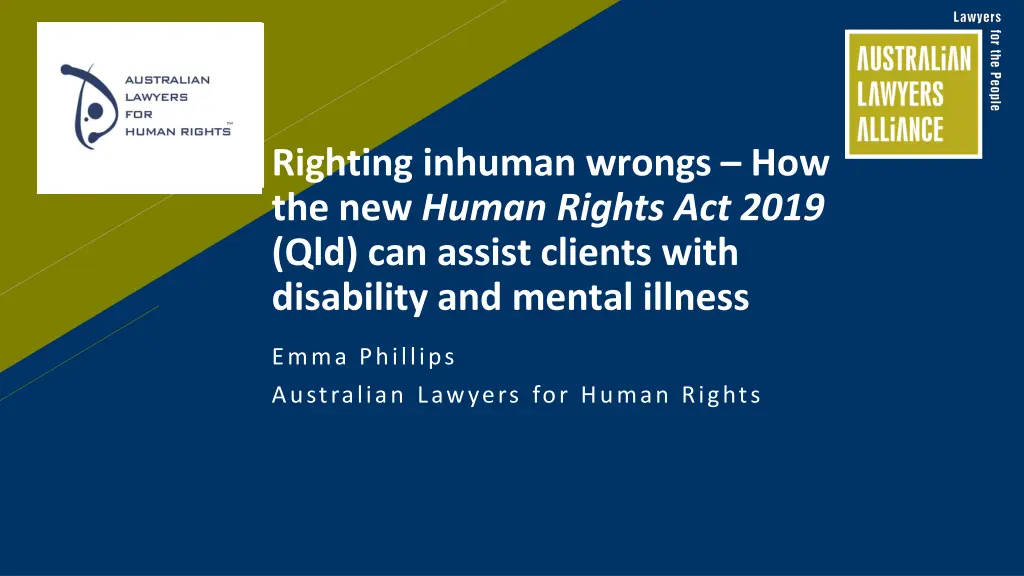
Understanding Human Rights Act 2019 (Qld) for Clients with Disability and Mental Illness
Learn how the new Human Rights Act 2019 (Qld) can support individuals with disabilities and mental illness, outlining key rights protected and the significance for vulnerable groups. Discover how this act offers a legal framework to address injustices and safeguard fundamental rights.
Download Presentation

Please find below an Image/Link to download the presentation.
The content on the website is provided AS IS for your information and personal use only. It may not be sold, licensed, or shared on other websites without obtaining consent from the author. If you encounter any issues during the download, it is possible that the publisher has removed the file from their server.
You are allowed to download the files provided on this website for personal or commercial use, subject to the condition that they are used lawfully. All files are the property of their respective owners.
The content on the website is provided AS IS for your information and personal use only. It may not be sold, licensed, or shared on other websites without obtaining consent from the author.
E N D
Presentation Transcript
Righting inhuman wrongs How the new Human Rights Act 2019 (Qld) can assist clients with disability and mental illness Emma Phillips Australian Lawyers for Human Rights
Legal disclaimer This PowerPoint Presentation contains general information about legal matters. The information is not legal advice and should not be treated as such.
Key things to know about the HRA It protects human rights the basic rights that belong to every person, regardless of age, race, sex, social status or other characteristic Protects the human rights of all people in Queensland Binds public entities core and functional Dialogue model human rights are taken into account across the three arms of government Accessible complaints mechanism Protects a range of human rights that Australia has agreed to protect at international law Most human rights are individual, some belong to groups (eg cultural rights)
What human rights are protected? Civil and political rights Recognitionand equality before the law Right tolife Protectionfrom tortureand cruel, inhuman or degrading treatment Freedom from forcedwork Freedom of movement Freedom of thought, conscience, religion and belief Freedom of expression Peacefulassembly and freedom of association Taking partin public life Propertyrights Privacy andreputation Protectionof families andchildren Cultural rights generally Right to liberty and security ofperson Humane treatmentwhen deprived of liberty Fairhearing Rights in criminal proceedings Children in thecriminal process Right not to be tried orpunished more than once Retrospective criminal laws Culturalrights of Aboriginal and TorresStrait Islander peoples Economic, social and cultural rights Right to education Right to healthservices
Human rights that are of particular significance for people with disability Recognition andequality beforethe law Rightto life Protection from tortureand cruel, inhumanor degradingtreatment Privacyandreputation Protection of families andchildren Rightto liberty and security of person Humanetreatment when deprivedof liberty Rightto education Right tohealthservices Freedomfrom forced work Freedomof movement Taking partin publiclife Propertyrights
Obligations of public entities Tomake decisions compatible with human rights Togive proper consideration to relevant human rights in makingdecisions, which includes: Identifying the human rights that may be affected by the decision; and Considering whether the decision would be compatible with human rights. Certain Children v Minister for Families and Children & Ors [2016] VSC 796 Minister for Families and Children v Certain Children [2016] VSCA 343 Certain Children v Minister for Families and Children (No 2) [2017] VSC 251
Limits to human rights The HRA allows for reasonable limits to be placed on human rights, which may be justified in a free and democratic society based on human dignity, equality and freedom . Proportionality test used to determine whether limitation is reasonable and justifiable. This test considers: nature of human right; purpose of limitation; relationship between limitation and purpose; whether there are less restrictive and reasonably available options; importance of purpose of limitation; and importance of safeguarding the human right. HRA permits decisions and actions that are not compatible with human rights if the decision maker could not reasonably have acted differently or made a different decision because of that other law (s58(2)).
Complaints mechanisms under the Act Mechanisms for addressing a human rights issue: 1. Raise issue directly with public entity 2. Lodge a complaint with QHRC (after 45 days) conciliation of complaint if accepted 3. Include human rights complaint as part of court action to protect another legal right Human rights legislation has a valuable role in: Addressingpower imbalances Resolving issues while keeping relationships intact
Right to recognition and equality before the law Section 15 (1) Every person has the right to recognition as a person before the law. (2) Every person has the right to enjoy the person s human rights without discrimination. (3) Every person is equal before the law and is entitled to the equal protection of the law withoutdiscrimination. (4) Every person has the right to equal and effective protection against discrimination. (5) Measures taken for the purpose of assisting or advancing persons or groups of persons disadvantaged because of discrimination do not constitute discrimination. Parks Victoria [2011] VCAT 2238
The right to life Section 16 Every person has the right to life and has the right not to be arbitrarily deprived of life. Rabone and Anor v Pennine Care NHS Foundation Trust (2012) SC (8 Feb 2012)
Protection from torture and cruel, inhuman or degrading treatment Section 17 A person must not be (a) subjected to torture; or (b) treated or punished in a cruel, inhuman or degrading way; or (c) subjected to medical or scientific experimentation or treatment withoutthe person s full, free and informed consent. Davies v State of Victoria [2012] VSC 343 (15 August 2012) Certain Children (No 1) [2016] VSC 796 [169]; contra Certain Children (No 2) [2017] VSC 251
Privacy and reputation Section 25 A person has the right (a) not to have the person s privacy, family, home or correspondence unlawfully or arbitrarily interfered with; and (b) not to have the person s reputation unlawfully attacked. Non-litigated examplesof the application of this right: to require provision of a shower curtain, to enable a woman with disability in a group home to shower with privacy and dignity(Vic); to challenge the use of CCTV camerasin the bedroom of a couple with disability (UK).
Protection of families and children Section 26 (1) Families are the fundamental group unit of society and are entitled to be protected by society and the State. (2) Every child has the right, without discrimination, to the protection that is needed by the child, and is in the child s best interests, because of being a child. (3) Every person born in Queensland has the right to a name and to be registered, as having been born, under a law of the State as soon as practicable after being born. This right has been relied upon to help to keep families intact with appropriate support and to prevent the forced removal of children from parents with disabilities.
Right to liberty and security of person Section 29 (1) Every person hasthe rightto liberty and security. (2) A person must not be subjected toarbitrary arrest or detention. (3) A person must not be deprived of the person sliberty except on grounds,and in accordance with procedures, established by law. (4) A person whois arrested or detained must be informed at the time of arrest or detention of the reason for the arrest or detention and must be promptly informed aboutany proceedings tobe brought againstthe person. (5) A person who is arrested or detained on a criminal charge (a) (b) (c) must be releasedif paragraph(a) or(b) is notcompliedwith. must be promptlybroughtbefore a court;and has the right to be brought to trial without unreasonable delay; and (6) A person awaiting trial must not be automatically detained in custody, but the person srelease may be subject to guarantees to appear (a) (b) (c) if appropriate,for executionof judgment. fortrial;and at any other stage of the judicial proceeding; and (7) A person deprived of liberty by arrest or detention is entitled to apply to a court for a declaration or order regarding the lawfulness of the person sdetention, and the court must (a) (b) ordertherelease of thepersonif itfinds thedetentionis unlawful. make a decisionwithoutdelay;and (8) A person must not be imprisoned only because of the person s inability to perform a contractual obligation. MH6 v MentalHealth Review Board(General) [2008] VCAT84 KB and others v Mental Health ReviewTribunal and Secretary of State for Health [2002] EWHC 639
Humane treatment when deprived of liberty Section 30 (1) All persons deprived of liberty must be treated with humanity and with respect for the inherent dignityof the human person. (2) An accused personwho is detained or a persondetained without chargemust be segregated from persons who have been convictedof offences, unlessreasonably necessary. (3) An accused person who is detained or a person detained without charge must be treated in a way that is appropriate for a person who has not been convicted. This right may be particularly relevant for persons with disability subject to practices such as lengthy solitary confinement and denied adequate supports and services while incarcerated.
The right to a fair hearing Section 31 (1) A person charged with a criminal offence or a party to a civil proceeding has the right to have the charge or proceeding decided by a competent, independent and impartial court or tribunal after a fair and public hearing. (2) However, a court or tribunal may exclude members of media organisations,other persons or the general public from all or part of a hearing in the public interest or the interests of justice. (3) All judgments or decisions made by a court or tribunal in a proceeding must be publicly available. Matsoukatidou v Yarra Ranges Council [2017] VSC 61 C v Chief Psychiatrist and anor [2011] ACTSC 195
The right to education Section 36 (1) Every child has the right to have access to primary and secondary education appropriate to the child s needs. (2) Every person has the right to have access, based on the person s abilities, to further vocational education and training that is equally accessible to all. Non-litigated example of the application of this right: this right has been relied upon in Victoria to help students with disabilityto access the supports they need to remain in mainstream schooling.
The right to health services Section 37 (1) Every person has the right to access health services without discrimination. (2) A person must not be refused emergency medical treatment that is immediately necessary to save the person s life or to prevent serious impairment to the person. Example of the potential application of this right: to challenge the denial of access to basic healthcare for people with disability detained in a forensic disability service or authorised mental health service. Castles v Secretary of the Department of Justice and Others (2010)28 VR 141
Other relevant rights to note Section 18: Freedom from forced work Section 19: Freedom of movement Section 23: Taking part in public life Section 24: Property rights AC (Guardianship) [2009] VCAT 1186 (8 July 2009) Secretary, Department of Justice v AB [2009] VCC 1132 (28 August 2009) Slatteryv Manningham CC [2013] VCAT 1869)
Building a human rights culture Human rights legislation has a valuable role in prompting development of a human rights culture Specifically: Recognising fundamental rights that can be raised in decision-making processes that engage a person s human rights, as a means of addressing power imbalances Resolving issues while keeping relationships intact Allowingfor complaints where necessary Training and education of the public sector The greatest value of the Act won t be in litigated outcomes, but in changes in the culture of government. A Federal Human Rights Act remains greatlyneeded.
Tips for lawyers Raise the HRA at earliest opportunity (eg in initialmeetings with Department) Use the HRA in a positive way,not only to protectclients from rights breaches but to call for positive action(eg right to support needed to ensure a properly inclusive education; right to support needed for a person with disability to parent) Raise human rights arguments in relevant forums Use the HRA wisely: Ordinary Act of Parliament (not constitutionally-entrenched), can be amended or repealed A strong collection of stories will help to protect our HRA to show its use and value Rely on it to compel decision-makers to consider human rights, challenge power imbalance and the unthinking application of bad policy BUT we also need to be careful about which cases we litigate In Victoria, early cases are still authoritative in shaping interpretation
Summary of key points The HRA is a powerful advocacy tool to protectthe rights and lives of people with disabilityin Queensland A number of the new rights can be used to target some of the human rights breaches experienced by people with disability Use it wisely, in a positive, proactive way,as the foundation for rights-based arguments Hopefully, as more jurisdictions gain human rights legislation, we are moving closer to having a Federal Human Rights Act or Charter
Thank You. Emma Phillips e: hra@alhr.org.au w: alhr.org.au

